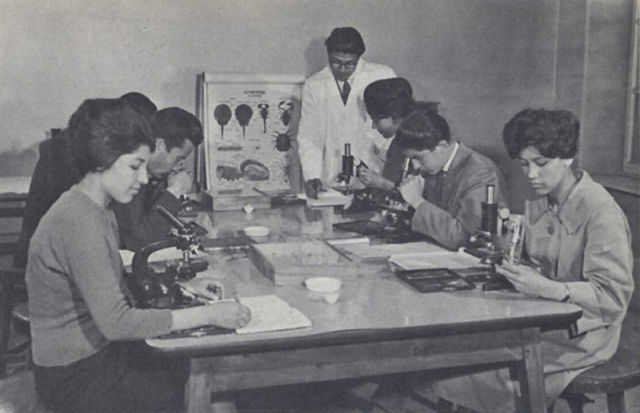 |
| School room in Afghanistan |
Afghanistan seems to have two types of education: an older traditional system, and one which is more progressive and adapted to modern times. Most of the Afghan populace lives in rural areas. As such, formal education for children living in rural villages is conducted by local religious leaders. Children in rural villages attend their nearest mosque for proper schooling. The mullah's teachings stress the religious scriptures of the Qur'an, as well as other subjects including reading, writing, and standard mathematics. More recently, actual schools have been constructed in remote, rural communities throughout Afghanistan. Schools have been built with aid from Western volunteers, most notably Greg Mortenson, whose Central Asia Institute has built over 131 schools in rural parts of Afghanistan and Pakistan.
 |
| University in Afghanistan in 1950s or 60s |
Though traditional education continues to be practiced, Afghanistan also has a history of proper education based on Western styles. Several universities, including Kabul University in 1932, were established in Afghanistan with assistance from Western and developed nations. Under the reign of King Zahir Shah, a constitution drafted in 1964 provided free and compulsory education, which meant free tuition and the extension of primary and secondary schools in the country. By the 1980s, Afghanistan was estimated to have 800 primary schools and 300 secondary schools.
 |
| School damaged by blast |
While Afghanistan seemed to have a progressive educational system prior to 1978, the outbreak of war in the country that year did considerable damage to established education in the country. The 1978 overthrow of the monarchy, the Soviet invasion in 1979 and the subsequent fighting in the 1980s virtually destroyed the educational system established by King Zahir Shah, and contributed to its poor state today. After the rise of the Taliban in 1996, education continued to decline because of policies banned the education of women, and mandated religious schools, madrassas, as the official source of primary and secondary schooling.
 |
| Afghan school girls |
Since the Taliban was overthrown by US and allied forces in 2001, the new interim government and coalition forces have continued to reconstruct Afghanistan's damaged education system, with considerable progress. As of 2010, an estimated 5.4 million Afghan students are enrolled in school, with 35% of them being girls. More school buildings are being built and he infrastructure of those buildings are continuing to be improved. Despite this optimistic sign, education in Afghanistan continues to face obstacles. Of the entire population, only 28.1% of Afghans can read, with the larger percentage being women. Funding for education is also struggling as the government's budget is reliant on donors for support. The insurgent Taliban also are waging a war against education by attacking schools that educate girls and by threatening and murdering teachers. Education in Afghanistan is on a long road to recovery before it can once more reach levels prior to 1978.
Sources include:
http://www.afghanistans.com/information/people/education.htm
http://en.wikipedia.org/wiki/Education_in_Afghanistan
http://www.afghan-web.com/education/
https://www.cia.gov/library/publications/the-world-factbook/geos/af.html
No comments:
Post a Comment